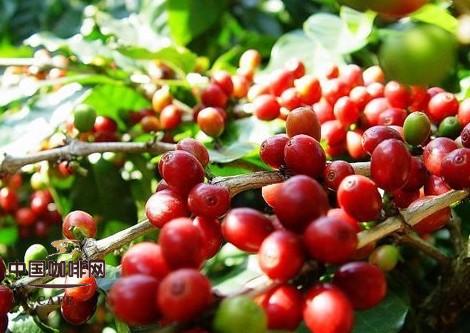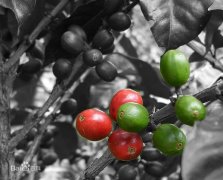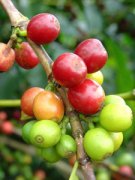Costa Rica San Romantara Beads Creamy and Slightly Spicy
Boutique coffee (specialty coffee) is also called "specialty coffee" or "select coffee". It refers to coffee made from a small number of raw beans with excellent taste grown in an ideal geographical environment. Depending on the special soil and climatic conditions in which they grow, they have outstanding flavor. After strict selection and classification, this kind of coffee can be regarded as a selection of coffee beans because of its hard texture, rich taste and excellent flavor.

The best coffee in Costa Rica seems to come from small processing plants, spread across several major coffee producing areas, including Tarazu and the western valley. This so-called coffee revolution originated 15 years ago and has greatly changed the way bean baking experts and importers think about Costa Rican coffee. Take the processing plant as the center, collect coffee beans from the surrounding small farms for processing, most of these farms are made up of small communities or families, growing coffee on their own small farms or land, and all the coffee is treated and dried by a small processing plant. The quality and flavor of Royal Coffee are very unique, which is largely due to the cooperation between coffee producers and us. St. Roman treatment plant, the use of water washing treatment, with a strong flavor. Coffee cherries are well-known for their rich and solid taste. Coffee cherries are hand-selected by coffee growers to remove overripe or immature cherries, and then production processing is carried out. 3 disc aagaarde peeling machine is used to remove the skin and pulp, and then the machine is divided into three grades according to the density of coffee beans. Grade 1 and 2 raw beans are fermented separately, while grade 3 is low-quality raw beans. The raw beans were fermented in a cool place for about 24 to 36 hours. After fermentation, the raw beans were washed and graded again according to the density on the cleaning channel, and then the raw beans were randomly soaked in clear water overnight. After the processed coffee has been roasted, the bitter sweet chocolate flavor is as thick and sweet as cream sugar, with low-key wine acidity and aroma, and the fruit sweetness of chocolate beans is forgettable.
Costa Rican coffee cultivation was introduced by Cuba in 1779 and exported for the first time in 1820. There are about 32000 coffee farmers, with an average planting area of less than one hectare (10000 hectares) per farmer. Costa Rica has a population of 41 billion (2006), with a coffee planting area of 82500 hectares and an annual production of 1.7 million bags (60kgs per bag). The annual domestic consumption is 380000 bags, with an average annual national consumption of 5.5kgs, which is higher than that of Japan (consumption 4kgs). At present, Taiwanese are only slightly higher than 1kg.
Important Notice :
前街咖啡 FrontStreet Coffee has moved to new addredd:
FrontStreet Coffee Address: 315,Donghua East Road,GuangZhou
Tel:020 38364473
- Prev

Traditional wet planing method Gayo Mountain area of Aceh Province, Indonesia tastes round and pure alcohol is extremely thick.
Indonesian coffee is very diverse in quality, most of which are based on the island origin as its market name: such as Sumatra, Sulawesi, Jawa or Timur. The advantage of Indonesian coffee is that most coffee is characterized by strong, introverted flavor and lively moderate acidity. Chinese people think highly of Indonesian Mandheling coffee.
- Next

Panama Café Castillo Tibika typica Red Catuai Pakamara Pac
Coffee made from fine coffee beans. Now it is mainly coffee made by hand brewing coffee to give play to the flavor of coffee beans themselves. Fine coffee has no bad effect on people's health, but moderate consumption is beneficial. Casa de la Casa covers an area of about 12.5 hectares. It is a miniature small estate in Panama. According to the owner's dictation, 8.5 hectares are planted.
Related
- Does Rose Summer choose Blue, Green or Red? Detailed explanation of Rose Summer Coffee plots and Classification in Panamanian Jade Manor
- What is the difference between the origin, producing area, processing plant, cooperative and manor of coffee beans?
- How fine does the espresso powder fit? how to grind the espresso?
- Sca coffee roasting degree color card coffee roasting degree 8 roasting color values what do you mean?
- The practice of lattes: how to make lattes at home
- Introduction to Indonesian Fine Coffee beans-- Java Coffee producing area of Indonesian Arabica Coffee
- How much will the flavor of light and medium roasted rose summer be expressed? What baking level is rose summer suitable for?
- Introduction to the characteristics of washing, sun-drying or wet-planing coffee commonly used in Mantenin, Indonesia
- Price characteristics of Arabica Coffee Bean Starbucks introduction to Manning Coffee Bean Taste producing area Variety Manor
- What is the authentic Yega flavor? What are the flavor characteristics of the really excellent Yejasuffi coffee beans?

